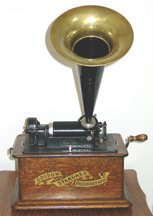Christmas Music
Below are some favorite Christmas songs. If you have Rhapsody, you can click here to automatically load the tracks in. I guess like any music recorded in the analog days, I think these classic Christmas songs have something special to them that I don't find in modern Christmas music. I know this is totally a subjective statement, but nothing of the last 20 years has made it into my list of Christmas classics. There's something about the old recordings--with the real orchestras, the booming reverb, rich choirs, and the reverent lead vocals--that really makes an impact. A modern recording with a glossy, crisp production and some sleigh bells overdubbed just seems so weak compared to these tracks. "Warm" has been overused to describe analog recording, but since it's Christmas, I get to trot out a cliche.
I wonder if in 20 years people will view 1980s-90s Christmas recordings as classics or if we'll keep coming back to these from the 40s,50s, and 60s. I think the recordings from the 40s,50s, and 60s represent the golden age of Christmas music and I don't think it will be equaled. Kind of like the Beatles and rock music.
Related to my posting on acoustic recording, I wonder if there are any vocal Christmas recordings done during the acoustic era. I'll have to check out the Tuesday antique music show to see if they play anything.
Merry Christmas.
1. Rockin' Around The Christmas Tree - Brenda Lee
2. Santa Claus Is Back In Town - Elvis Presley
3. Silver Bells - Bing Crosby
4. Joy To The World - Nat King Cole
5. O Little Town Of Bethlehem - Frank Sinatra
6. Silent Night - Sister Rosetta Tharpe
7. Have Yourself A Merry Little Christmas - Ella Fitzgerald
8. Do You Hear What I Hear? - Do-Re-Mi Childrens Chorus
9. It Came Upon The Midnight Clear - Johnny Mathis
10. Mistletoe And Holly - Frank Sinatra
11. Christmas Will Be Just Another Lonely Day - Brenda Lee
12. What Child Is This? (Greensleeves) - Mahalia Jackson
13. Frosty The Snow Man - Gene Autry
14. O Holy Night - Mahalia Jackson
15. We Three Kings of Orient Are - The Beach Boys
16. I Wonder As I Wander - Joan Baez
17. God Rest Ye Merry Gentlemen - Bing Crosby
18. If Every Day Was Like Christmas - Elvis Presley
19. The Christmas Song - Booker T. & The MG's
20. Christmas Time Is Here (Instrumental) - Vince Guaraldi
Technorati Tags: recording, music, christmas
I wonder if in 20 years people will view 1980s-90s Christmas recordings as classics or if we'll keep coming back to these from the 40s,50s, and 60s. I think the recordings from the 40s,50s, and 60s represent the golden age of Christmas music and I don't think it will be equaled. Kind of like the Beatles and rock music.
Related to my posting on acoustic recording, I wonder if there are any vocal Christmas recordings done during the acoustic era. I'll have to check out the Tuesday antique music show to see if they play anything.
Merry Christmas.
1. Rockin' Around The Christmas Tree - Brenda Lee
2. Santa Claus Is Back In Town - Elvis Presley
3. Silver Bells - Bing Crosby
4. Joy To The World - Nat King Cole
5. O Little Town Of Bethlehem - Frank Sinatra
6. Silent Night - Sister Rosetta Tharpe
7. Have Yourself A Merry Little Christmas - Ella Fitzgerald
8. Do You Hear What I Hear? - Do-Re-Mi Childrens Chorus
9. It Came Upon The Midnight Clear - Johnny Mathis
10. Mistletoe And Holly - Frank Sinatra
11. Christmas Will Be Just Another Lonely Day - Brenda Lee
12. What Child Is This? (Greensleeves) - Mahalia Jackson
13. Frosty The Snow Man - Gene Autry
14. O Holy Night - Mahalia Jackson
15. We Three Kings of Orient Are - The Beach Boys
16. I Wonder As I Wander - Joan Baez
17. God Rest Ye Merry Gentlemen - Bing Crosby
18. If Every Day Was Like Christmas - Elvis Presley
19. The Christmas Song - Booker T. & The MG's
20. Christmas Time Is Here (Instrumental) - Vince Guaraldi
Technorati Tags: recording, music, christmas






